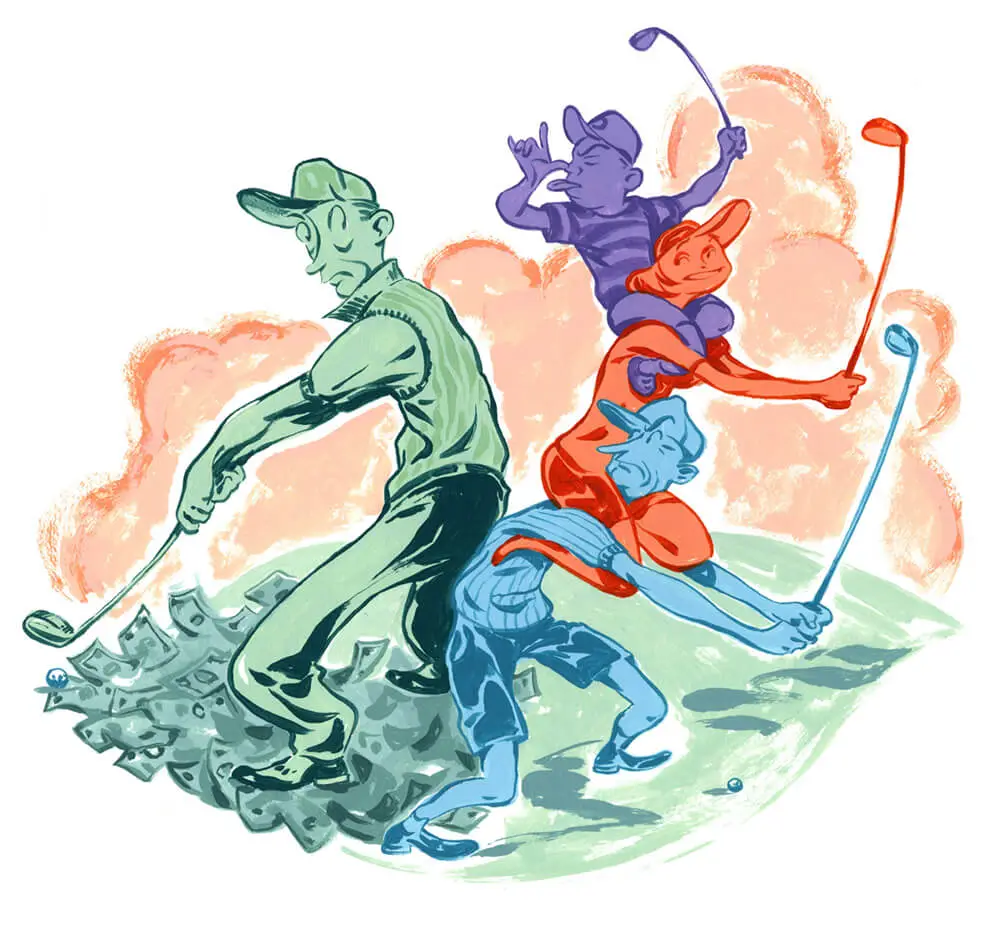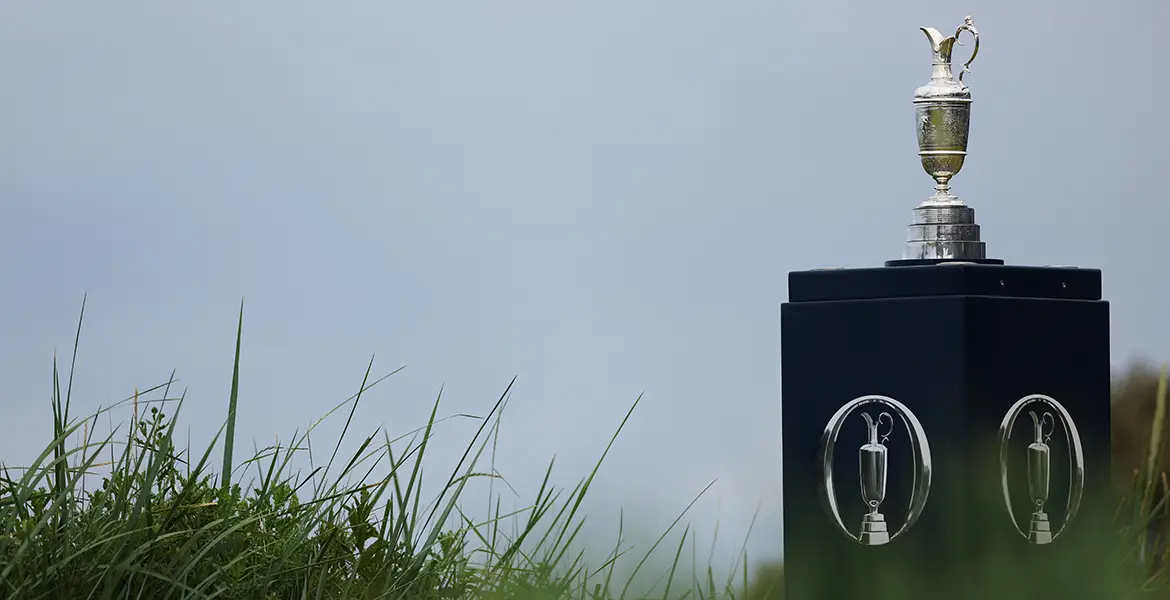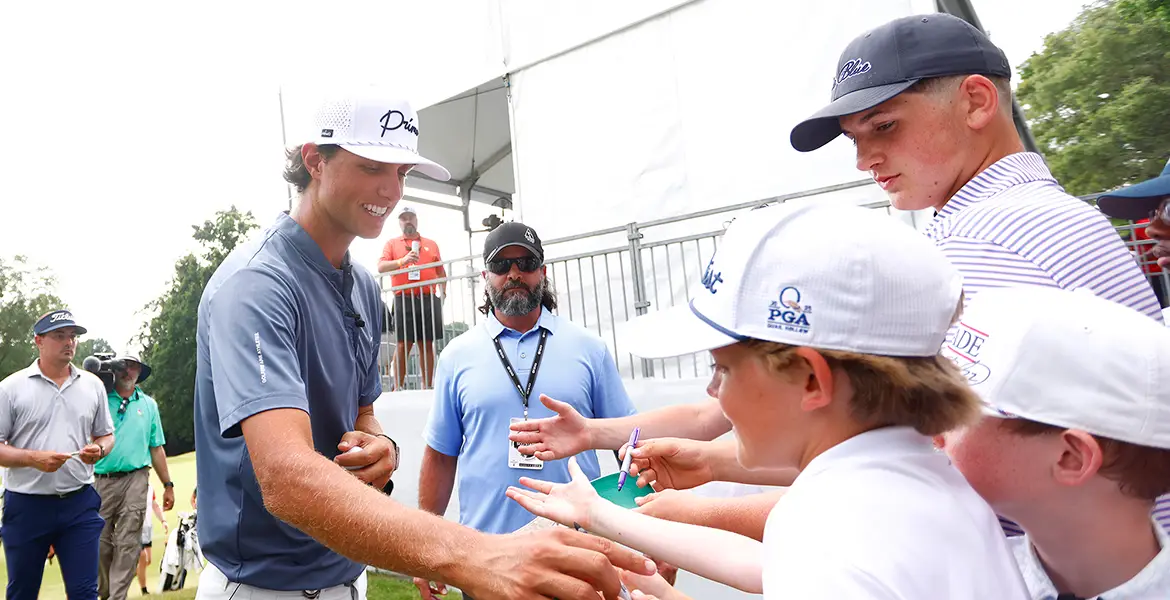The more pro golfers squabble over obscene amounts of money, the less the public will care. And that’s just fine.
The verdict is in. A sport played in some form by 70 or so million around the globe does not hinge on the popularity of the few hundred or so professionals who believe they are centers of our universe. The numbers do not lie. Even with terrible weather in key regions, according to Golf Datatech, U.S. rounds played are up 3 percent over 2022 with magnificent spikes in female and junior participation. An unexpected pandemic bump has turned into a steady bounce even with offices demanding that workers return and less time-consuming threats like pickleball competing for recreational time.
Everyday golf has proved to be resilient, unmoored from the fortunes, grievances, and neuroses of those who play it for a living.
Dating back to when Young Tom Morris won so many silver belts they had to let him keep it and create a Claret Jug, and all the way up to the emergence of Tiger Woods, bursts of popularity have been tied to the dashing ways of generational talents. These special players convinced people to take up the Royal and Ancient pastime. Watching bigger-than-life types pursuing history without concern for cash gave the sport convenient boosts: Bobby Jones, Ben Hogan, Babe Zaharias, and Arnold Palmer injected new life at key moments. They helped the masses discover or rediscover golf as a brilliant, if a tad peculiar, pastime. A reverse effect might have been expected based on 2023’s morass of international headlines reinforcing touring pros as cartoonishly selfish.

Instead, all traceable trends suggest a record number of people are calling themselves golfers. Flat or falling media viewing numbers suggest longtime viewers have moved on from the logoclads. The inspiration to play, dream, practice, invest, and live vicariously through golf now comes from non-pro golf sources. And while many well-meaning overlords have issued dire pleas that a sport “splintered” between LIV and the PGA Tour would be perilous, 2023 proved the Saudi Arabia-driven divorce will remain largely a nonissue for the everyday sport and surrounding businesses.
Golf has shown people it’s more than just something to do safely outdoors. It’s a lifestyle and guiding force for many. A safe place for kids and a healthy pastime for older folks. Grass roots efforts to “grow” the sport have worked. There are (finally) easier and less intimidating ways into golf. More options have been added for those who cannot play 18 holes on a Saturday at the club. Years of effort by leading organizations to make the sport more welcoming have shown up in the numbers even as this newfound popularity has inflated costs for equipment, green fees, travel, and memberships. Because instead of taking cues from the elites traveling (private, no less) around the country playing beautiful courses for millions, the golfing public finds inspiration elsewhere.
Some folks—I’m only slightly judging here—take inspiration from the pursuits of the influencer set because they look like they’re having fun playing golf. Millions more with less time to play 18 holes still are enjoying the benefits of improving through practice on upgraded ranges or short courses. Instruction is more fun, supported by revealing launch-monitor data that makes a game of suggesting swing tweaks based on the numbers. More golfers than ever are architectionados: Some travel to check off ranked courses, but most are seeking out rich experiences and the ensuing fun of debating design merits that produce memories of a lifetime. All of this is far removed from the week-to-week pro game.
On the commerce side, just look at the number of fun and sophisticated niche brands that have forced the industry behemoths to reevaluate their approach and improve their offerings. The inspiration to play more golf and ignore the pro game is also coming from infusions of technology, incredible (and environmentally healthier) course maintenance, better food, more relaxed fashion, clever use of social media to show off the beauty of golf courses as places to rejuvenate the soul, and the long overdue embrace of time-friendly alternatives like par-3 courses and Topgolf. Yet there is still too much desperation to “grow the game” even though we all know that phrase is only uttered by those who have never tried hitting refresh on a webpage hoping to secure a tee time.
The game has grown. It’s cool with kids and the retiring boomers. Is it sustainable given the increasing costs? That’s still a matter of concern, and, thankfully, there are smart people at the USGA, R&A, GCSAA, NGF, and regional golf associations on top of these things.
While many well-meaning overloards have issued dire pleas that a sport “splintered” between LIV and the PGA Tour would be perilous, 2023 proved the Saudi Arabia-driven divorce will remain largely a non-issue for the everyday sport and surrounding businesses.
Their jobs would be easier without a professional game determined to taint the strides made by making the sport more palatable for more people. There are still too many courses under threat despite serving a vital purpose in their communities. Golf is still viewed as a vast waste of resources played by a small set of elitists, and pro golf’s money wars only drive this home. Another year of silly money thrown about, most of it caught by Jon Rahm, has sharpened the focus on player greed, the kind regularly described by people who love the game as awful and disgusting. It’s no wonder folks outside the sport still unfairly lump golfers and courses into a big waste pit of excess. Hearing pros threatening a jump to LIV because there are not enough executive restrooms or on-site parking for their caddie’s sport psychologist is enough to make even die-hard golfers hate the pros.
It’s little wonder, then, that ratings are falling and playing professionals are no longer seen as brand icons to blue chip companies. While most are still fantastic role models to be admired for their skill, the crossfire hurricane of trends suggests the recreational game and ecosystem around it will continue to drift away from the 300 or so male professionals who believe they are the sport. Or worse, bigger than it.
With the major tours failing to find common ground and much sense, the insular money jockeying will only end when the cash starts to dry up. By then it’ll be too late for the pro game and the majors will be the only time we watch. Thankfully, the rest of golf can see the unanimous verdict: The game will be fine with or without the pros. It’s a beautiful thing. And a testament to the enduring spirit of a royal and ancient pursuit.
Thank you for supporting our journalism. If you prefer to read in print, you can also find this article in the Winter 2024 issue of LINKS Magazine. Click here for more information.







I applaud Geoff Shackelford’s article on the lessening need of professional golfers. As an avid golfer ( my wife calls me a nut), I find myself caring less and less about who will jump to LIV, or the decreasing quality of the PGA Tour as a result.
My interest has always started with the first PGA event of the year through the last telecast in late fall. Could not wait to tune into Kapalua.
The constant badgering between both sides, the constant talk of the monies being paid now parallels other pro sports.
I used to think that professional touring pros were a different breed of athlete.
Now I realize that PGA titles, majors, etc. are not important to them.
After all, tough to live on career earnings of $ 6mil. to 15 mil.
They just don’t care.
Jim Thrall
Torrington CT
Pro golfers have forgotten entirely that they are, or should be, essentially nothing more than entertainers who exist solely at the discretion of those who are willing to support them either through sponsorship or viewing. As viewers are more put off TV numbers will drop, sponsors will question the value of the spend and ultimately purses will decline and nature will be restored. Or not.
The Netflix program was not a beneficial look at the lives of many of the pros on both PGA and LIV tours. You saw their greed, self values being exposed as I am a special person and deserve respect for because I believe I am above everyone else playing this game. The exchange on the private jet of Justin Thomas and Jordan Speith flipping cards at $1000 a hand was totally a slap in the face to millions of people that can’t afford food or housing. The tours do help raise money for many charities and some players have organizations they support to help to fund children’s heath care and those in dire need. That is a good thing. But the costs of equipment and apparel have dramatically increased way above inflationary levels and I never have bought golf products because some pro uses them. Now with LIV exposing the PGA Management’s weaknesses of not just the amount payed to the players, but also the treatment of caddies and others that support these players has made them react to protect themselves and their reputation and exaggerated salary’s. The product all professional sports offer is entertainment and time for the those that watch them to get away for brief moments to the hate, corruption, destruction of their lives and moral values by these athletes and the people that support the sports. The amount of players that live their lifestyle not as Gods children is disappointing and not providing some role modeling for our next generation. The games will survive but when we really hit some financial extreme hardships world wide, again you will see a very negative impact to the sports elitism and people participating and watching the games.
Geoff’s article is right on target. The fact that more people are enjoying the game of golf today has nothing to do with the professional tours. The viewership numbers suggest that more people are out enjoying the game rather than watching the “logoclads.” (I love that term.) I’m also fairly certain that the majority of people who constantly talk about “growing the game” are really interested in growing the pot of money that flows into the game. Nothing wrong with that, business is business, and most businesses want to grow, but it does get tiresome hearing them play the grow-the-game card.
Geoff Shackleford was amazingly cognizant in reading my mind before he wrote this article. For longer than I can remember, I couldn’t wait to start watching the PGA Tour beginning with the Hawaii events, then to California, etc. This year I have watched a grand total of, maybe, four hours of golf. I turn it on and see a leaderboard, 80% of names I’ve never seen before. Then I see the “explanation” of how the next five or next ten players not currently qualifed can qualify for the next event (The Drive for Five or some similar quirky-supposedly-catchy-sounding name) and I’m lost five seconds into it. Even Dan Hicks, who is reading it from a teleprompter, seems to be confused. Then I usually turn it off. Like everyone, I’m looking forward to the Masters, but nothing between now and then.
As Geoff emphasizes, it’s mostly the money that is a turn-off and I’m certainly in that club. The obscene money and the PGA hypocrisy. When LIV began, the standard criticism was it’s only about money. “What a travesty of the game- paying guaranteed amounts of money to all participants! In a limited field no less!” Then, remarkably, the PGA develops Signature Events where (a mere coincidence I’m certain) there are no cuts and everyone is paid guaranteed money. And the total purses are $20 milliion. Team Golf is the silliest thing in the history of the game…….until Tiger and Rory develop a Team Golf concept and now players are lobbying for spots on one of the teams. As Val Kilmer as Doc Holliday whispered on his deathbed: “My hypocrisy knows no bounds.”
On another, but just as important tangent, finding a place to play, at least in the Charlotte area, is becoming next to impossible. Thousands of people are moving here every month, and some percentage of them are golfers. There have been no new golf courses built in the metropolitan area in decades, and in fact two have closed and developed as just more high-density housing. Most country clubs have waiting lists, including the high-end ones like Carmel and Quail Hollow, but also the more typical neighborhood country clubs. Those that do have openings have increased initiation and monthly fees 200-300% or more. I personally think the affordability of golf is quickly reaching a tipping point, as the overwhelming majority of new courses being built are high-end resort and destination courses with accompanying high-end green fees. So Geoff, a topic for your next article, maybe?
Yes. The history and tradition remain.
I also won’t stop playing guitar and piano because I may not like where popular music is going. Both music and golf = good for the soul. Yes, pro players and top music artists have some genuinely great back stories, but overall “industries” get way out of touch. Well said Geoff!